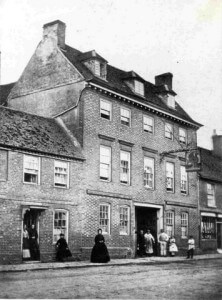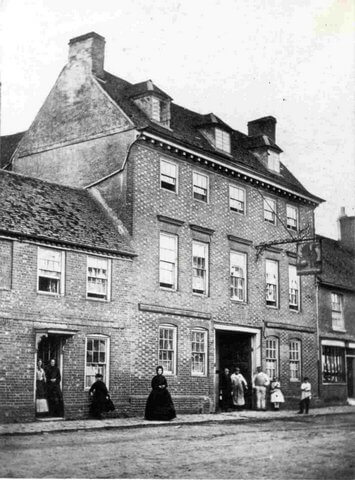Ambrose Bennett and the curious case of the body in the High Street
This article was written by Chalfont St Peter based DJ Kelly who is the author of Buckinghamshire Spies and Subversives; The Famous & Infamous of The Chalfonts & District and The Chalfonts and Gerrards Cross at War, all available via local book shops and at Amazon.
As mentioned elsewhere on this website in connection with the persecution of local Quakers, there was a particularly unfortunate and unsavoury incident involving a local magistrate and a prominent local Quaker. The unusual nature of this incident perhaps demands further exposition.
The incident

In 1655, Ambrose Bennett, a Buckinghamshire Justice of the Peace, en route to the courthouse at Aylesbury, was tipped off that there was to be a Quaker funeral that same morning in Amersham. Being a staunch persecutor of the Quakers, he assembled a posse of police constables and a rabble of local roughnecks and bid them wait on hand in the High Street whilst he himself took a table in the window of The Griffin Hotel from where he could, in comfort, watch out for the arrival of the funeral procession. Whilst there it is most likely he also partook of some alcoholic beverages to fortify his resolve.
When the mourners appeared in the High Street, en route to the Friends’ Meadow burial ground in Whielden Street, Bennett left his cosy billet and sallied forth into the High Street to accost the procession. According to an eye witness account by one of the mourners, one Thomas Ellwood, Bennett drew his sword and used it to strike Thomas Dell, one of the leading coffin bearers, in an attempt to dislodge the load. Dell held on steadfastly to the coffin but Bennett immediately ordered the Friends to set down the coffin upon the highway. Out of respect for their dead friend, however, they declined to do so.
Enraged, Bennett set the rough necks upon the mourners and the coffin was snatched from them and dashed to the ground, much to the distress of the deceased man’s widow and family. Bennett had the constables arrest some of the mourners and disperse the rest. He ordered that the coffin should be left in the centre of the open highway and there it remained, exposed to the strong sunlight of the day and into the late evening, where all horses and carriages which passed were obliged to detour around the coffin, lest they run over the deceased.
Later that night, Bennett had the coffin and the body – which in law was the property of the deceased’s widow – removed and buried, not in the Friends’ burying ground but in an unconsecrated patch of ground in Amersham churchyard. Those he had arrested were bound and brought before Bennett’s friend and fellow magistrate, Sir Thomas Clayton, who committed them all – without trial – to Aylesbury Gaol, where they remained for up to a month. Ellwood would spend most of that year in Aylesbury Gaol.
The notion of human remains being treated with such disrespect and buried without benefit of clergy or mourners may seem horrible to us today but in 1655, when folks were more God fearing and perhaps more sensible to religious slight, this incident would have been quite horrific. But who were the people involved and what were the circumstances which gave rise to such a shocking event?
Ambrose Bennett
As a member of the landed class, barrister-at-law Ambrose Bennett (sometimes written as Benet) was automatically appointed to the office of Justice of the Peace. As a nephew of the wealthy Sir Simon Bennett who left money in his will to University College, Ambrose was admitted to the college fellowship. Allegations of financial misdealing caused the college to tighten up their procedures on the disbursement of funds, upon which Bennett resigned his fellowship. We may make of that what we will. He next sailed to Virginia to take advantage of the beneficence of yet more wealthy relatives, one being Governor of Virginia and another a major ship owner who had become rich transporting Puritan settlers to that colony.
Ambrose soon sold off 1,000 acres of land he had been given in the colony, and returned to England, where he married a daughter of the Baronet of Taplow, acquiring a generous dowry and a great deal more land in Buckinghamshire, including the estate of Hedgerley Bulstrode. Bennett set about altering and updating Bulstrode to a standard more befitting his status and wealth. During the work, however, the building caught fire and was destroyed. A 1664 court case which the litigious Bennett brought against local gentleman Richard Whitchurch of Chalfont St Peter (for non performance of the terms of a lease and non payment of dues) may have failed since Bennett’s copy of the lease was destroyed in the house fire, along with many other manorial documents.
Bennett was one of a number of Buckinghamshire JPs, described as being ‘over zealous’ in their persecution of anyone they suspected of being disloyal to King Charles II (who reigned from 1650 to 1685) and, in Bennett’s book, this included religious dissenters such as the Quakers. The existence of a Friends Meeting House established in Hedgerley in the 1650s proved an irritant to Bennett, who frequently harassed the Quakers who went there. Another of the ‘over zealous’ and anti-Quaker local JPs was Bennett’s friend, the aforesaid Sir Thomas Clayton, who had acquired from the King’s brother the estates of The Vache at Chalfont St Giles, following its seizure from the Fleetwood family at the restoration of the monarchy.
The Deceased
The deceased man whose remains were treated so unceremoniously was Edward Perrott, a prominent Amersham Quaker and a wealthy maltster. Ironically, it had been Perrott himself who had purchased and donated the land for the Friends’ Meadow burying ground. A great number of British Quakers appear to have been maltsters during this period which is in itself curious. The likely reason is that discrimination against persons of the Quaker faith led to them being disbarred from higher education and public service. Being driven into agriculture initially and later finding that trade and industry presented the only occupations open to the more enterprising and capable of them, many Quakers progressed naturally from growing valuable crops of barley, hops and malt into the lucrative area of brewing these into beer.
By the nineteenth century, the misery and degradation brought about by drink led to the start of the Temperance Movement, which the Quakers too embraced. Many of them now switched to manufacturing non-acoholic products such as drinking chocolate and malted milk beverages, as well as chocolate and other confectionary. Quaker families such as the Cadburys, Frys, Rowntrees, Huntleys and Palmers became brand leaders in this field. Working and living conditions for the workers in their factories were good in comparison with those of other contemporary employers although, as author Sarah Moss recounts in her book Chocolate: A Global History (Edible), they also used slave labour to work their sugar plantations and, in common with many other employers, they insisted their women workers resign upon marriage. Back in 1655 however, some of the mourners waylaid by Bennett at Edward Perrott’s funeral were his fellow maltsters, including the Amersham based John Nash and Jeremiah Steevens (sic) of Chepping Wycombe (High Wycombe).
The Persecuted
The well known and much persecuted local Quaker Thomas Ellwood, whose first-hand account of the incident at Perrott’s funeral appears in his diaries, that same year took out a lease on a cottage in Chalfont St Giles on behalf of his friend, the poet Milton, bringing him out from the plague ridden capital and encouraging him to write Paradise Regained whilst living there. Ellwood himself lived intermittently in Amersham and Chalfont St Peter but would move to Coleshill in 1669 in order to avoid further persecution and imprisonment. Unusually, Coleshill was at that time (and up until 1844) a detached part of Hertfordshire which had only poor road access from the county which administered it. Being outside of the influence of the aforesaid Buckinghamshire JPs, Coleshill offered Ellwood some respite from the persecution.
Changing Times
A certain degree of religious tolerance came about in 1689 with the succession to the British throne of King Charles’ niece Mary – daughter of Charles’ unpopular brother and successor King James II – and her husband William of Orange. It was in that same year that the Friends’ Meeting House in Whielden Street was licensed as a place of worship.
So far as can be established, Edward Perrott was never reinterred in the Friends’ Meadow which he had so generously given, though his widow and her second husband were. As for the wicked Ambrose Bennett, however, his innate greed and profligacy led to his being sued for significant debt. The court system which he had so often used against others now went against him. He was forced to sell off Bulstrode and return to Virginia. Greatly dismayed to find that, most ironically, all his former Puritan settler friends there had been converted to the Quaker faith by George Fox, in 1673 he set off to try to establish a new fortune in the plantation and slave trade in Jamaica. However, very shortly after his arrival in Jamaica, he died.

